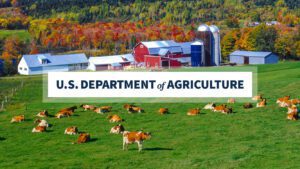The U.S. Department of Agriculture today announced that it is providing approximately $208 million in automatic financial assistance for qualifying farm and emergency loan borrowers. This announcement is made possible by $3.1 billion in assistance for distressed farm loan borrowers provided in Section 22006 of the Inflation Reduction Act, an important part of President Biden’s Investing in America agenda.
To help prevent foreclosures, USDA will cover approximately $80 million in delinquencies for an estimated 210 borrowers whose qualifying guaranteed loans were flagged for liquidation as of Nov. 30, 2023. USDA will also provide approximately $128 million for an estimated 1,120 borrowers with currently outstanding direct Emergency Loans as of Nov. 30, 2023. Any distressed borrowers who qualify for this assistance and are currently in bankruptcy will be addressed using the same case-by-case review process announced in October 2022 for complex cases.
“At USDA, we are working hard every day to keep farmers on their farms. With the Inflation Reduction Act, we’ve begun charting a very different course than the one taken during the farm financial crisis in the 1980s,” said Agriculture Secretary Tom Vilsack. “We continue to work on credit reforms centered around this better approach and I encourage our lenders and borrowers alike to work with our local offices and our cooperators to capitalize on all available flexibilities in these important programs prior to foreclosing or liquidating farms.”
Since the Inflation Reduction Act was signed by President Biden in August 2022, USDA’s Farm Service Agency has provided approximately $1.7 billion in immediate assistance to more than 30,000 distressed borrowers as part of an ongoing effort to keep borrowers farming and ranching, remove obstacles that currently prevent many borrowers from returning to their land, and improve the way that FSA approaches borrowing and loan servicing in the long-term. More options to prevent avoidable guaranteed loan foreclosures are currently being developed.
For any qualifying guaranteed borrowers that also qualified for previous Inflation Reduction Act assistance announced in October 2022 or August 2023, payments may be adjusted to account for that assistance.
Individual Requests for Distressed Farmers Seeking Assistance
In addition to the assistance announced today, FSA continues to accept individual distressed borrower assistance requests from direct loan borrowers who missed a recent installment or are unable to make their next scheduled installment on a qualifying direct farm loan due to cash flow issues, or those distressed borrowers who took certain extraordinary measures to avoid delinquency on their qualifying direct loans. More information on eligibility criteria for this assistance may be found on the Inflation Reduction Act Assistance for Distressed Borrowers page.
Borrowers can submit requests in person at their local FSA office or by sending in a direct request using the extraordinary measures or cash flow-based assistance portals found on farmers.gov. All requests for extraordinary measures or cash flow-based assistance must be received by Dec. 31, 2023.
Important Tax Information
Like the other USDA Inflation Reduction Act assistance, payments provided to borrowers and payments to be applied to FSA farm loan accounts will be reported to the Internal Revenue Service. Borrowers will receive a 1099 form from FSA. Please note that payments over $600 are subject to federal and state income taxes and will be reflected on the annual 1099 form. Borrowers are encouraged to consult a tax professional with all tax-related questions regarding any Inflation Reduction Act assistance received. USDA also has tax-related resources at farmers.gov/taxes.
USDA touches the lives of all Americans each day in so many positive ways. In the Biden-Harris administration, USDA is transforming America’s food system with a greater focus on more resilient local and regional food production, fairer markets for all producers, ensuring access to safe, healthy and nutritious food in all communities, building new markets and streams of income for farmers and producers using climate-smart food and forestry practices, making historic investments in infrastructure and clean energy capabilities in rural America, and committing to equity across the Department by removing systemic barriers and building a workforce more representative of America. To learn more, visit www.usda.gov.
***Courtesy of the U.S. Department of Agriculture***













